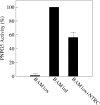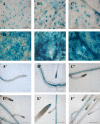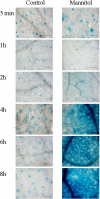Thioredoxin-regulated beta-amylase (BAM1) triggers diurnal starch degradation in guard cells, and in mesophyll cells under osmotic stress
- PMID: 20876336
- PMCID: PMC3003804
- DOI: 10.1093/jxb/erq288
Thioredoxin-regulated beta-amylase (BAM1) triggers diurnal starch degradation in guard cells, and in mesophyll cells under osmotic stress
Abstract
BAM1 is a plastid-targeted β-amylase of Arabidopsis thaliana specifically activated by reducing conditions. Among eight different chloroplast thioredoxin isoforms, thioredoxin f1 was the most efficient redox mediator, followed by thioredoxins m1, m2, y1, y2, and m4. Plastid-localized NADPH-thioredoxin reductase (NTRC) was also able partially to restore the activity of oxidized BAM1. Promoter activity of BAM1 was studied by reporter gene expression (GUS and YFP) in Arabidopsis transgenic plants. In young (non-flowering) plants, BAM1 was expressed both in leaves and roots, but expression in leaves was mainly restricted to guard cells. Compared with wild-type plants, bam1 knockout mutants were characterized by having more starch in illuminated guard cells and reduced stomata opening, suggesting that thioredoxin-regulated BAM1 plays a role in diurnal starch degradation which sustains stomata opening. Besides guard cells, BAM1 appears in mesophyll cells of young plants as a result of a strongly induced gene expression under osmotic stress, which is paralleled by an increase in total β-amylase activity together with its redox-sensitive fraction. Osmotic stress impairs the rate of diurnal starch accumulation in leaves of wild-type plants, but has no effect on starch accumulation in bam1 mutants. It is proposed that thioredoxin-regulated BAM1 activates a starch degradation pathway in illuminated mesophyll cells upon osmotic stress, similar to the diurnal pathway of starch degradation in guard cells that is also dependent on thioredoxin-regulated BAM1.
Figures










Similar articles
-
β-amylase 1 (BAM1) degrades transitory starch to sustain proline biosynthesis during drought stress.J Exp Bot. 2016 Mar;67(6):1819-26. doi: 10.1093/jxb/erv572. Epub 2016 Jan 20. J Exp Bot. 2016. PMID: 26792489
-
β-Amylase1 and β-amylase3 are plastidic starch hydrolases in Arabidopsis That Seem to Be Adapted for Different Thermal, pH, and stress conditions.Plant Physiol. 2014 Dec;166(4):1748-63. doi: 10.1104/pp.114.246421. Epub 2014 Oct 7. Plant Physiol. 2014. PMID: 25293962 Free PMC article.
-
Regulation of Leaf Starch Degradation by Abscisic Acid Is Important for Osmotic Stress Tolerance in Plants.Plant Cell. 2016 Aug;28(8):1860-78. doi: 10.1105/tpc.16.00143. Epub 2016 Jul 19. Plant Cell. 2016. PMID: 27436713 Free PMC article.
-
Chloroplast thioredoxin systems: prospects for improving photosynthesis.Philos Trans R Soc Lond B Biol Sci. 2017 Sep 26;372(1730):20160474. doi: 10.1098/rstb.2016.0474. Philos Trans R Soc Lond B Biol Sci. 2017. PMID: 28808108 Free PMC article. Review.
-
Starch degradation.Annu Rev Plant Biol. 2005;56:73-98. doi: 10.1146/annurev.arplant.56.032604.144257. Annu Rev Plant Biol. 2005. PMID: 15862090 Review.
Cited by
-
A Brassica napus Reductase Gene Dissected by Associative Transcriptomics Enhances Plant Adaption to Freezing Stress.Front Plant Sci. 2020 Jun 26;11:971. doi: 10.3389/fpls.2020.00971. eCollection 2020. Front Plant Sci. 2020. PMID: 32676095 Free PMC article.
-
Intra-Sample Heterogeneity of Potato Starch Reveals Fluctuation of Starch-Binding Proteins According to Granule Morphology.Plants (Basel). 2019 Sep 4;8(9):324. doi: 10.3390/plants8090324. Plants (Basel). 2019. PMID: 31487879 Free PMC article.
-
Redox Regulation of Starch Metabolism.Front Plant Sci. 2018 Sep 21;9:1344. doi: 10.3389/fpls.2018.01344. eCollection 2018. Front Plant Sci. 2018. PMID: 30298078 Free PMC article.
-
The evolution of functional complexity within the β-amylase gene family in land plants.BMC Evol Biol. 2019 Feb 28;19(1):66. doi: 10.1186/s12862-019-1395-2. BMC Evol Biol. 2019. PMID: 30819112 Free PMC article.
-
A pivotal role for starch in the reconfiguration of 14C-partitioning and allocation in Arabidopsis thaliana under short-term abiotic stress.Sci Rep. 2018 Jun 18;8(1):9314. doi: 10.1038/s41598-018-27610-y. Sci Rep. 2018. PMID: 29915332 Free PMC article.
References
-
- Amodeo G, Talbott LD, Zeiger E. Use of potassium and sucrose by onion guard cells during a daily cycle of osmoregulation. Plant and Cell Physiology. 1996;37:575–579.
-
- Basu PS, Ali M, Chaturvedi SK. Osmotic adjustment increases water uptake, remobilization of assimilates and maintains photosynthesis in chickpea under drought. Indian Journal of Experimental Biology. 2007;45:261–267. - PubMed
-
- Buchanan BB, Balmer Y. Redox regulation: a broadening horizon. Annual Review of Plant Biology. 2005;56:187–220. - PubMed
Publication types
MeSH terms
Substances
LinkOut - more resources
Full Text Sources
Molecular Biology Databases
Research Materials

